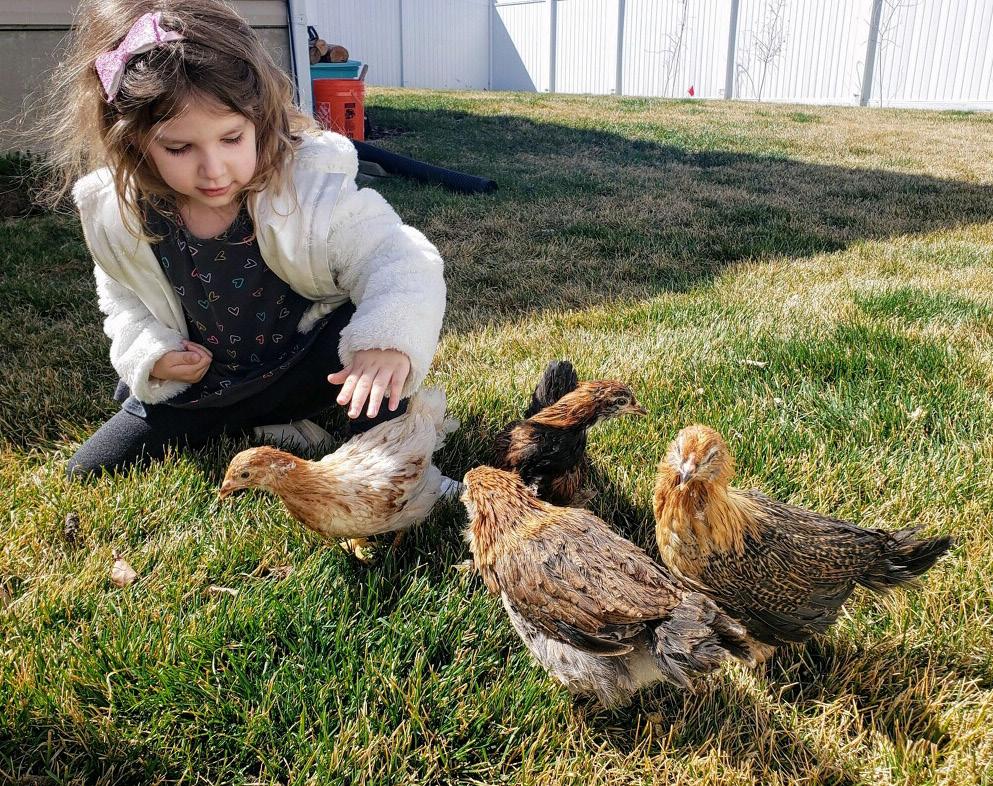
24 minute read
Homesteading & Backyard Gardening
40 Acres Not Necessary
Utahns are Homesteading in Urban Backyards
Advertisement
By Nicole Anderson
Utahns are known for their food storage and preparedness methods, and have been encouraged for years to acquire food storage and a 72-hour kit in case of an earthquake or other emergency. For those who did, that storage came in handy during last year’s woes. While many of us had a difficult time believing that we were, in fact, experiencing a pandemic during our lifetime, others simply continued on, knowing that no matter what happened, they would be fine. In April of 2020, a poll posted at “@UtahPolicy, indicated 37% of households feel they are very prepared, and 56% feel somewhat prepared” to withstand the coronavirus pandemic.” With the closure of businesses, mask mandates, and quarantine orders, 2020 felt like the apocalypse. Thousands of
people were laid off from work creating a huge need for basic necessities such as food. While many of us had a difficult time believing that we were in fact experiencing a pandemic during our lifetime, others simply continued on, knowing that no matter what happened, they would be fine. With that in mind, many folks did what others were already doing — they took to homesteading and backyard gardening to combat the shortage of certain products, or to simply avoid the store entirely. Homesteading doesn’t have the same connotation it did during the era of the pioneers when folks literally put a stake in the ground to claim their land. In today’s world, homesteading means having chickens, growing a garden, beekeeping, or possibly raising goats or pigs. Not only does homesteading put dinner on the table, it also offers a way to make some extra cash by selling produce, eggs, and honey. And, if you can’t sell it all, you can donate it to a local food bank to help combat hunger in your community. If you spend some time hanging out at your local Intermountain Farmers Association (IFA), you will undoubtedly run into folks putting their gardening skills to work. The store is buzzing with activity and this is just one location where folks come to learn new skills and bond over turnips, carrots, and potatoes. Baby chicks are undeniably cute, but remember that they are flocking birds, so you can’t get just one. They begin to lay eggs after about five to six months and will likely produce far more than your family can eat. They are a great learning experience and fun to have. Ron Miller from Bluffdale, a California transplant as of last year, is adapting to his new lifestyle on his two-acre lot where he is now tilling the dirt and getting his hands dirty planting crops. When asked about his harvest last year,
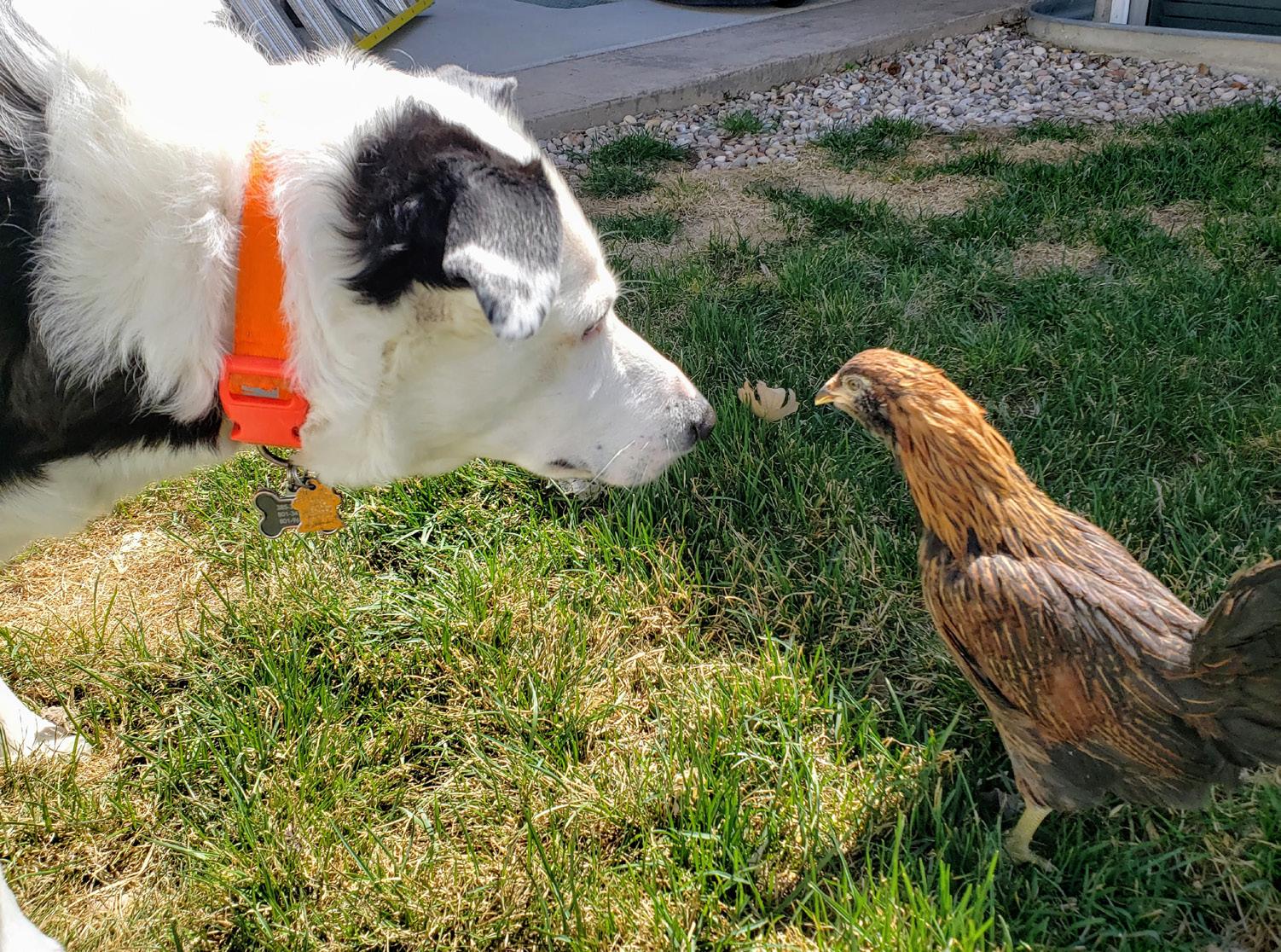

he grabbed his camera and quickly said, “let me show you.” He flipped through the photos of brightly colored bell peppers, tomatoes, and a new salsa blend of hot peppers, showing them to several folks who were waiting in line. He excitedly discussed the special colored corn he is going to grow for the kids. He explained that his son set up a card table in their front yard and sold almost $100 worth of produce every night. Another gentleman, John Zhang, chimed in and mentioned that it was a great way for kids to learn the value of hard work. People grow a garden for all types of reasons, but one of the main reasons lately is to be selfefficient and not depend on other sources for food. If you are new to these activities, you can sign up for classes at most CAL Ranch, Tractor Supply, or IFA stores; not to mention the USU Extension Service offers a Master Gardener Course where you learn basic botany, weed science, entomology, and landscape design. Just knowing what companion plants you can grow with tomatoes or that sunflowers are toxic to other plants is a blessing to any new gardener. Perhaps you’d rather plant a bee friendly garden with lavender, Russian sage and penstemon flowers? If that’s you, throw in some herbs, fruits, and vegetables such as mint, pumpkin, and raspberry bushes to help nourish bees in their natural environment. If you are into beekeeping, you must be registered with the Utah Department of Agriculture and make sure to follow the rules such as “the bees must have easy access to water on the owner’s property.” Hives must be placed so that general flight patterns avoid contact with humans and domestic animals, and hives must be maintained according to the Utah Bee Inspection Act. You can learn more at SLC. gov about beekeeping in Salt Lake City and surrounding areas. There is much to learn about backyard gardening and homesteading. It’s good for your health, both mind and body, to get a little dirt on your hands. I encourage you to explore gardening even if you only plant an herb collection on your kitchen counter. I am sure it will bring a smile to your face when they grow, and we could all use more smiles these days.

The chestnut mushroom is known for its nutty flavor Adam Wong, owner of Intermountain Gourmet Mushrooms, grows a variety of unique fungi from his facility in Ogden
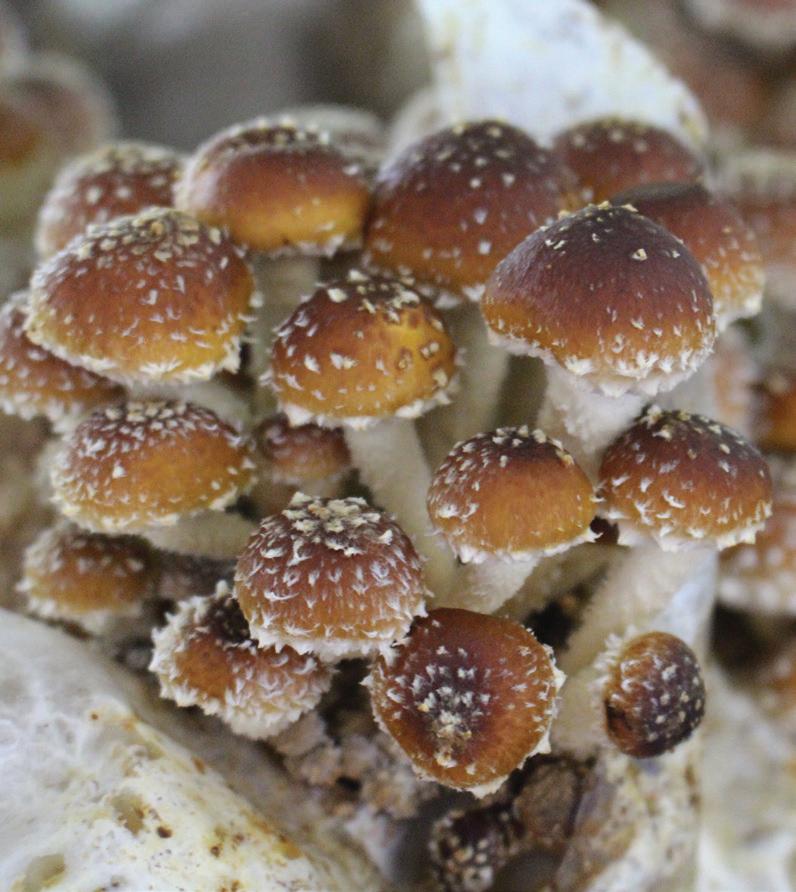
Shroom Boom
Ogden Mushroom Farm Brings Colorful Fungi to Utah
By Claire McArthur
For a long time, the mushroom selection at most grocery stores was unimpressive: white or brown, button or cremini. Maybe a few portobellos thrown in for good measure. But in recent years, mushrooms — and their diverse shapes, textures and flavors — are having their moment in the sun.
While there are more than 10,000 known types of mushrooms (and mycologists suspect this is only a fraction of what’s out there), there are around 300 that are considered edible and about 30 that are domesticated. In
Ogden mushroom farmer Adam Wong is producing a whole range of colorful shrooms in his highly controlled indoor facility for restaurants, grocery stores, and farmers markets. Wong started Intermountain Gourmet Mushrooms nearly seven years ago after learning the ins and outs of growing mushrooms from friends who were running a now-defunct mushroom farm in Salt Lake City. “It’s the challenge of it,” Wong says of his draw to growing mushrooms. “There are a lot of variables to get the mushroom to perform its best throughout all the stages. It’s a trial and error process. When you think you have it dialed in, something completely off-rails you.” While it may be called “farming” mushrooms, the process is a far cry from throwing seeds in the soil. It all starts with spores — the mushroom’s microscopic reproductive unit — cultivated on petri dishes in Intermountain Gourmet’s lab. As the spores germinate, Wong breaks them up and adds them to bags of moist
Intermountain Gourmet Mushrooms harvest between 700 to 1,000 pounds of mushrooms a week from its highly controlled fruiting rooms.
sterilized grain which the mycelium — the vegetative part of a fungus made up of a network of fine white filaments — begins to consume. Next, Wong takes the colonized grain and adds it to sterilized bags of sawdust and other nutritional amendments and puts them in the temperature-controlled fruiting room where they are misted four to six times an hour. Depending on the mushroom, it can take anywhere from three to 16 weeks for the mushrooms to fruit. Currently, Intermountain Gourmet produces anywhere from 700 - 1,000 pounds of mushrooms every week, including oyster, shiitake, pioppino, lion’s mane, king trumpet, chestnut, woodyear, maitake, beech, and reishi. “During the summer months when the farmers markets are going, we grow the whole rainbow spectrum of oysters: pink oysters, blue oysters, brown oysters, yellow oysters,” adds Wong. The oyster is a good ‘starter mushroom’ for those who are only familiar with the ubiquitous white button. “Anything you can do with a button mushroom, you can do with an oyster, and it has a little more flavor and packs a better health punch as well,” says Wong. “My other favorite, shiitake, goes well with Asian food and pastas. They are really meaty with an umami flavor.” Wong also makes a limited supply of tinctures using reishi, which has been shown to have a number of health benefits. Restaurants from Park City to Provo use Intermountain Gourmet in creative ways. This year shoppers can now purchase Wong’s mushrooms in Harmons. “Mushrooms are easy but difficult at the same time to grow. They grow outdoors in nature in unsterile conditions, but when you try to control that and get the most efficiency then there’s a lot that can go wrong,” explains Wong. “But we plan to keep expanding. There’s a few new kinds of mushrooms we’re trying to dial in on a larger scale, so we’ll continue refining the process until it’s ready.”
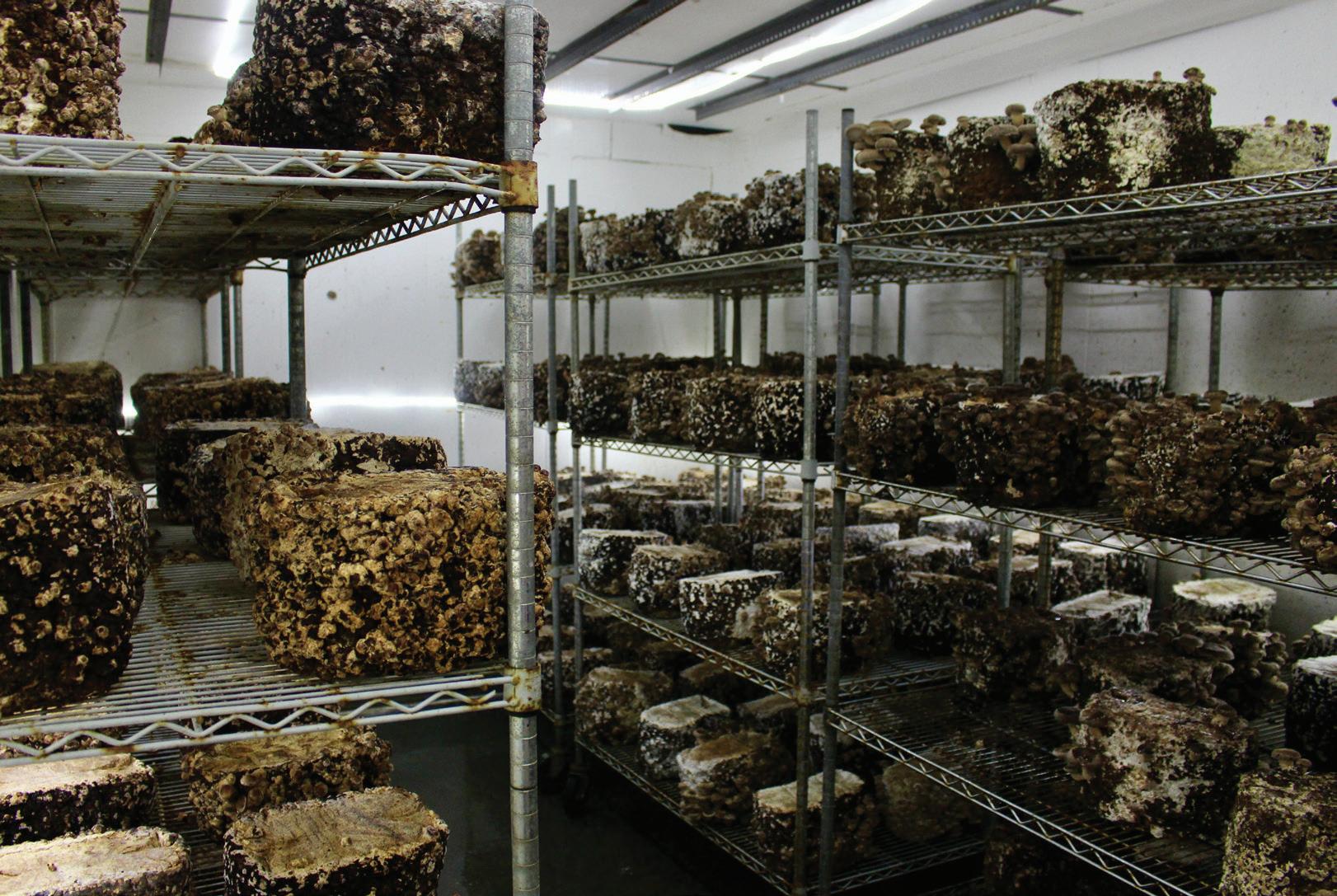
What’s Cooking with Closed Sugar House Sizzler

Restaurant Site For Sale at 5.5 Million Dollars
By Amiee Maxwell
When the Sizzler on the corner of 2100 South and 1300 East in Sugar House shut its doors for good last fall, my husband was oddly devastated. Although he hadn’t dined there in 29 years, he felt comfort in the stability it represented.
“It has been there my whole life,” he laments. It was one of the few remaining monuments of the Sugar House he knew as a kid, and the lot it sits on is now for sale for a whopping 5.5 million bucks. One of America’s first casual steakhouse chains, Sizzler filed for Chapter 11 bankruptcy in September 2020, citing the effects of the Coronavirus pandemic. Many restaurant chains have suffered throughout the COVID-19 pandemic, but Sizzler has been in a general decline in recent years according to data from Restaurant Business, and this wasn’t Sizzler’s first bankruptcy filing.
The question of what will take Sizzler’s place in Sugar House is bringing out strong emotions in the community. It’s the only privately-owned site in Sugar House Park, and with the multi-million dollar price

tag, there are few options that could prove profitable for potential investors.
According to Judi Short, chair of the Sugar House Community Council Land Use & Zoning Committee, the parcel would have to be rezoned to allow for something that would make money for the property owner. So, one of the few things that could provide a worthwhile profit would be an apartment complex, and Short says she’s heard that it would need to be at least ten stories tall to provide a good return on investment.
Respondents to a community survey overwhelmingly opposed another apartment in Sugar House, especially one so tall on the corner of a park. Less than a dozen of the more than 300 comments received wanted to see the lot rezoned for apartments, and a majority of the comments favored incorporating the lot into the park. Suggestions included expanding the entrance to the park, adding green space, or opening a new restaurant or coffee shop—something park visitors could use.
Short approached the city about acquiring the lot but does not know if they are looking into it. Considering the 5.5 million dollar price tag, it’s unlikely the city is seriously interested. “The city doesn’t have a pot of gold sitting around,” says Short.
No real proposals have come through at this time, and although it seems like an apartment may be the only option to justify the high price, constructing one on that corner will not be without difficulty. The 0.82-acre site is very small, and access would be a challenge given the busy 2100 South and 1300 East intersection. All parking would have to be onsite, considering parking is not allowed on either street or in the park overnight. An apartment would most likely need more acreage, but as it is, the Sugar House Park Authority is not able to sell any land to the Sizzler parcel because under their agreements, any use of their land has to be for open space.
A new developer has approached the city about a possible land swap, but the details of this are unknown at the present time. Short apologized for the non-answer when I asked her about the fate of the lot, but there just aren’t any answers at this time. My husband says it would have been easier if the lot just stayed a Sizzler. “That was the Sizzler’s home. Nobody ever thought or questioned its existence even though it is the one business in the park,” he says. According to him, the lot can only become part of the park or it must go back to being a Sizzler.
Down On The [Urban] Farm

A Visit With Frog Bench Farms
By Ted Scheffler
You could drive right past it a dozen times and not even know it’s there. But tucked away on a quiet, residential street in a neighborhood near Foothill Boulevard is an urban farm that supplies produce, cut flowers, microgreens, and more to many of our area’s finest restaurants. It’s called Frog Bench Farms. Nearly 10-years-old now, Frog Bench Farms was created in 2012 by Paula and Joe Sargetakis. Prior to that, the couple had been co-owners of a Napa Valley winery. I recently chatted with Joe and Paula about urban farming, amateur gardening, supplying restaurants with boutique produce, and where the name “Frog Bench” came from.
TS: As former winery owners, are there a lot of similarities to growing wine grapes and growing produce on a farm or is it apples to oranges, so to speak? Paula: I would say it’s apples to oranges in the sense that if you plant a fruit tree or vine, they just stay there and do their

thing year after year. Whereas the majority of what we grow is not perennial. So you’re always maintaining; you’re always harvesting, and then rotating into your next crop — there’s constant change.
Joe: Grapevines don’t require as much attention. You’re working a couple of hours every couple of weeks for the most part on the vines. I would say gardening is much more labor intensive and attention intensive.
TS: When most people think of farming, they think of rural locations. How or why did you choose to put your farm in the middle of an urban neighborhood? Paula: I remember us talking at my great grandmother’s house on 7th East about how years ago neighbors would all share produce. Some people could grow tomatoes; others would grow cucumbers, and they would share them. But today most people in Utah can’t walk to a grocery store that sells fresh local produce. So it struck me that we needed that in our society and in our community. So we started looking for a spot for an urban farm and we wanted it to be next to a school so that the kids could see where their food comes from.
TS: What sort of challenges has the pandemic presented to you during the past year or so? Paula: Well, business-wise we lost 100 percent of our business in 24 hours, so that sucked. [Laughing] But with restaurants closed we did a pivot and started selling to the public and they have been amazingly supportive. We’ve been really blessed how well things have gone for us. Joe: We said to our staff, ‘We will keep you employed; we will figure out a way.’ So we got some PPP funds and were able to access some County funds and were able to pay our bills and keep our staff working and now, finally, we’re starting to see some movement again on the restaurant side. It’s been great though — our quasi-CSA Public Pick Up Program — because people are so
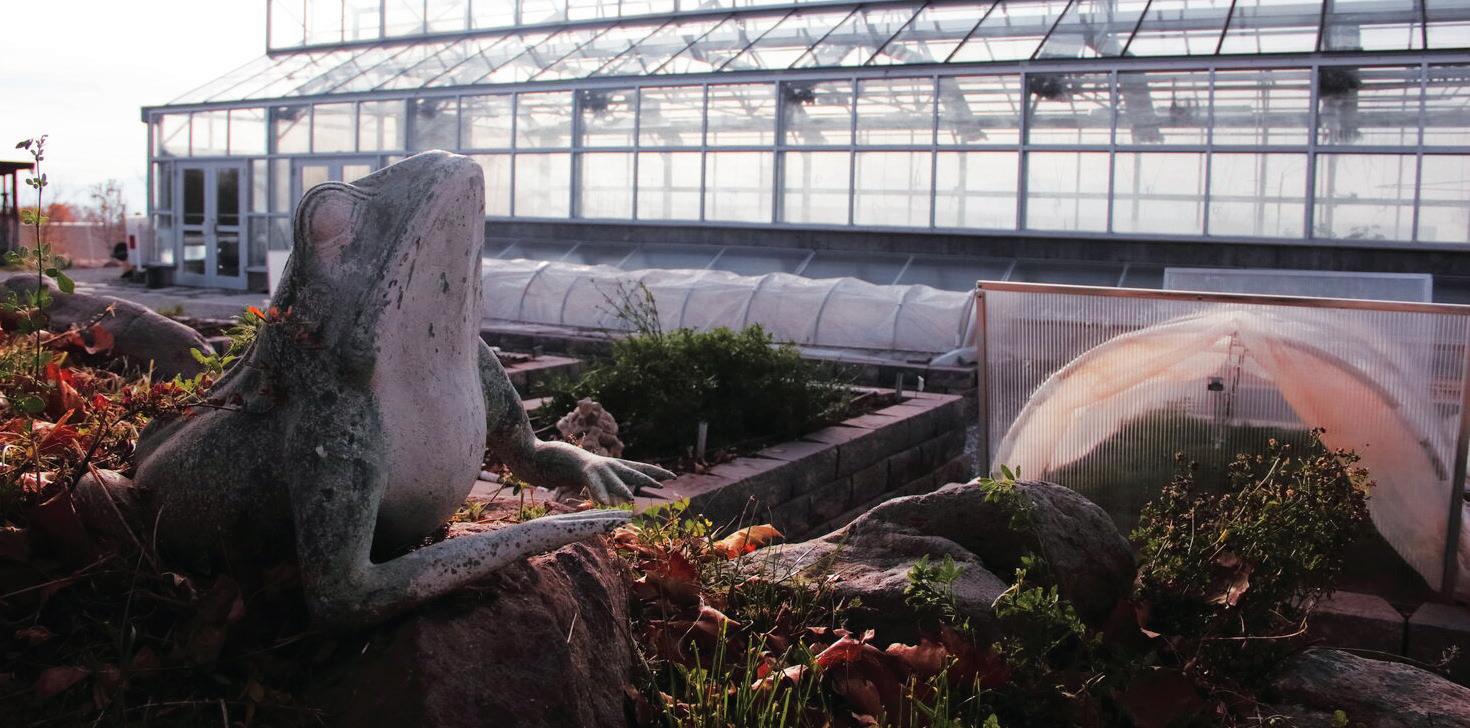
appreciative to be able to have really fresh, local produce. They can sign up to get a text once a week from us telling them what we have available and if they want anything they just text us back. It’s really been wonderful, and once COVID is just a bad memory, we’ll still do it; it’s fun to get out of the garden and meet retail customers. TS: I know this is a Sophie’s Choice type of question. But, do you have a favorite restaurant dish or two that utilizes Frog Bench Farms ingredients? Joe: A couple of my favorites are at SLC Eatery. They take our Tokyo turnips and frost them with chunky peanut butter and miso sauce and we love it so much that now we emulate it at home. And then they do grilled calamari with popped rice that they use a number of our microgreens with, and that is an awesome dish.
Paula: Microgreens are really underrated. People think they’re just a pretty little garnish, but many of them have very deep flavors, add quite a bit to a meal, and are nutritious as all get out. TS: You guys are pros. But what advice or tips do you have for amateur or beginner gardeners to share?
Paula: The first thing to do it to get your soil as healthy and nurtured as it can be, because it will save you time in the end, and whatever you’re growing will be much happier and healthier. And then my second recommendation is just because someone says you can’t grow something, doesn’t mean you can’t. If you want to grow it, give it a try. Pick one thing that you like to eat and grow it in your yard and taste the difference from a store bought vegetable or fruit. And get kids involved in growing and eating fresh foods. Joe: And don’t believe that you can’t grow all winter long in Utah. We grow lettuce, spinach, turnips and such in January and February. We supply chefs with their favorite produce, microgreens and so on but basically, we grow what we like to eat. When we started the Farm we didn’t have any clients so we didn’t know what to grow. So we grew what we wanted to eat. TS: So now, the really big question: Where does the name Frog Bench Farms come from. Paula: [Laughing] Well, for some reason my entire life I’ve loved frogs. I don’t know why. And, we’re located up on a bench. And it’s a farm. [More laughter]
Frog Bench Farms




Subscribe to Utah Bites Newsletter and learn about Utah’s BEST restaurants!


Oquirrh Restaurant
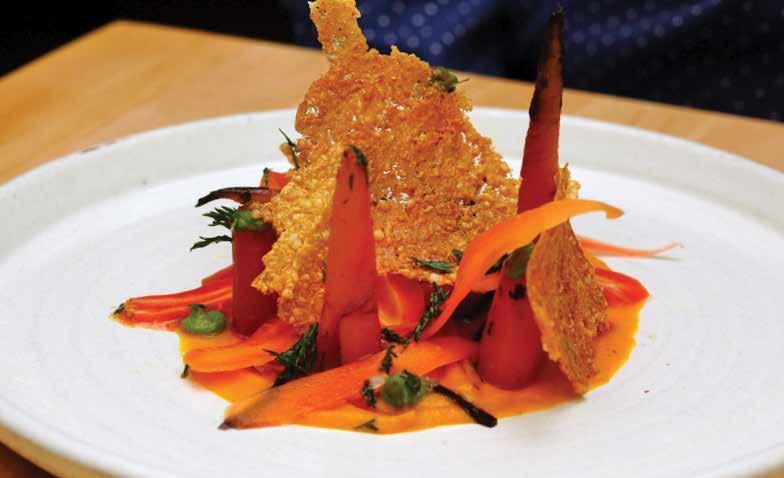
The Freshness The Freshness Factor Factor
Garden-Fresh Local Flavor at Utah Restaurants Garden-Fresh Local Flavor at Utah Restaurants
By Ted Scheffler By Ted Scheffler Although the term “farm to table” might be a tad overworked these days, there Although the term “farm to table” might be a tad overworked these days, there really is a bevy of discerning local chefs with caper-date puree and sesame garlic crunch. In addition, customers can really is a bevy of discerning local chefs and restaurateurs who place a high value delight in SLC Eatery’s Frog Bench Farms and restaurateurs who place a high value on freshness and do their damndest to Greens: a sensational salad made with a on freshness and do their damndest to source produce locally whenever possible. blend of fresh local greens, cucumber, source produce locally whenever possible. That means that you really can get a beets, whipped feta, falafel croutons, and That means that you really can get a fresh, healthy meal with a smallish carbon zippy pepperoncini vinaigrette. Who says fresh, healthy meal with a smallish carbon footprint in many of our best Utah eateries. healthy, fresh eating has to be boring? footprint in many of our best Utah eateries. Here are a few tasty examples.
Here are a few tasty examples. Manoli’s
with caper-date puree and sesame garlic crunch. In addition, customers can delight in SLC Eatery’s Frog Bench Farms Greens: a sensational salad made with a blend of fresh local greens, cucumber, beets, whipped feta, falafel croutons and zippy pepperoncini vinaigrette. Who says healthy, fresh eating has to be boring?
SLC Eatery
SLC Eatery At SLC Eatery, chef/owners Paul At SLC Eatery, chef/owners Paul Chamberlain and Logen Crew turn to Chamberlain and Logen Crew turn to local Frog Bench Farms for their Tokyo local Frog Bench Farms for their Tokyo Turnip cart menu item, which comes
Turnip cart menu item, which comes
Manoli’s Manoli Katsanevas — the talented, Manoli Katsanevas — the talented, hospitable, and creative chef of his hospitable, and creative chef of his namesake restaurant, Manoli’s — prides namesake restaurant, Manoli’s — prides himself on incorporating the freshest, himself on incorporating the freshest, local ingredients into his Mediterraneanlocal ingredients into his Mediterranean-
inspired cuisine from producers such as New Roots Farm. So the star of his inspired cuisine from producers such revithosalata vegetarian mezze dish, as New Roots Farm. So the star of his for example, is sauteed locally-foraged revithosalata vegetarian mezze dish, mushrooms with homemade hummus, for example, is sauteed locally-foraged pine nut dukkah, and roti. And the glutenmushrooms with homemade hummus, free roka salad is superb: fresh local pine nut dukkah and roti. And the glutenarugula combined with seasonal fruit, free roka salad is superb: fresh local house-made mizithra, toasted almonds arugula combined with seasonal fruit, ,and white balsamic vinaigrette. Of course, house-made mizithra, toasted almonds being Greek, Manoli knows a thing or two and white balsamic vinaigrette. Of course, about lamb. So, he sources his lamb from being Greek, Manoli knows a thing or two local Morgan Valley Lamb. You do not want about lamb. So, he sources his lamb from to miss his next “lamb on the spit” special local Morgan Valley Lamb. You do not want dining event at the restaurant. It’s manna to miss his next “lamb on the spit” special for lamb lovers. dining event at the restaurant. It’s manna for lamb lovers. Afterword
At Heber’s Afterword restaurant, Afterword partners Maggie Alvarez and Matt Harris At Heber’s Afterword restaurant, incorporate fresh ingredients from their partners Maggie Alvarez and Matt Harris own farm in Midway into many of the incorporate fresh ingredients from their delectable dishes served there. So you own farm in Midway into many of the can bet that items sprinkled across the delectable dishes served there. So you Afterword menu like local mushrooms, can bet that items sprinkled across the sauteed kale, winter squash, house-made Afterword menu like local mushrooms, sauteed kale, winter squash, house-made kimchi, sweet pepper jam, garlic puree, potato & parsnip hash, roasted cauliflower, kimchi, sweet pepper jam, garlic puree, charred leek vinaigrette, raspberry coulis, potato & parsnip hash, roasted cauliflower, and many more probably came from no charred leek vinaigrette, raspberry coulis, more than a few miles away. Now that’s and many more probably came from no fresh and local. more than a few miles away. Now that’s fresh and local. Provisions
Tyler Stokes — chef/owner of Provisions Provisions restaurant — has been using fresh, local Tyler Stokes — chef/owner of Provisions foods in his cooking since the day he restaurant — has been using fresh, local opened his east side eatery. Frog Bench foods in his cooking since the day he Farms supplies items like braising greens, opened his east side eatery. Frog Bench arugula, spinach and such to Provisions Farms supplies items like braising greens, so you can count on uber freshness from arugula, spinach and such to Provisions something like the Wedgeless Wedge so you can count on uber freshness from Salad with baby gems, radish, Asian pear, something like the Wedgeless Wedge sunflower seeds, and smoked bacon ranch Salad with baby gems, radish, Asian pear, dressing. Even Stokes’ Shaking Beef dish sunflower seeds and smoked bacon ranch utilizes local watercress, scallions, and red dressing. Even Stokes’ Shaking Beef dish onions to fire up the deliciousness factor. utilizes local watercress, scallions and red onions to fire up the deliciousness factor. Oquirrh Oquirrh restaurant is about nothing if Oquirrh not locally sourced, scrumptious American Oquirrh restaurant is about nothing if fare. So when you order the Oquirrh not locally sourced, scrumptious American fare. So when you order the Oquirrh
Hell’s Backbone Grill

Caffe Molise

Salad — whole leaf lettuce, buckwheat, garden sprouts, and toasted sunflower garden sprouts, and toasted sunflower seed vinaigrette — you know you’re eating seed vinaigrette — you know you’re eating local. And all those microgreens you see local. And all those microgreens you see deliciously garnishing many of the dishes deliciously garnishing many of the dishes at Oquirrh? Yep, they’re all from a farm at Oquirrh? Yep, they’re all from a farm less than a mile as the crow flies from the less than a mile as the crow flies from the restaurant.
restaurant.
Caffe Molise Caffe Molise
The freshness factor is flying high at Caffe Molise, where chef/owner Fred Caffe Molise, where chef/owner Fred Moesinger uses fresh wild mushrooms Moesinger uses fresh wild mushrooms and caramelized onions on polenta with and caramelized onions on polenta with fresh-made tomato sauce and gorgonzola fresh-made tomato sauce and gorgonzola in his Polenta con Funghi antipasti dish. in his Polenta con Funghi antipasti dish. And what could be more fresh than the And what could be more fresh than the Spinaci at Caffe Molise: fresh spinach with Spinaci at Caffe Molise: fresh spinach with wild mushrooms, roma tomatoes, fresh wild mushrooms, roma tomatoes, fresh mozzarella cheese, red onion, pine nuts mozzarella cheese, red onion, pine nuts and balsamic vinaigrette. and balsamic vinaigrette.
Hell’s Backbone Grill Hell’s Backbone Grill
knowing that they are laced with fresh Hell’s Backbone Farm ingredients such as roots & bulbs, greens, cucumbers, heirloom fruits, squash, potatoes, herbs, and even eggs from their flock. It just doesn’t get much more local than that.
At Hell’s Backbone Grill in Boulder, At Hell’s Backbone Grill in Boulder, chef/owners Jen Castle and Blake Spalding chef/owners Jen Castle and Blake Spalding emphasize regional cuisine using a vast emphasize regional cuisine using a vast amount of locally-produced ingredients, amount of locally-produced ingredients, including many from their own farm, including many from their own farm, which is an organic, no-harm farm. which is an organic, no-harm farm. Whether you’re enjoying the Bowl of Three Whether you’re enjoying the Bowl of Three Sister Posole, French Onion Soup, or Goat Sister Posole, French Onion Soup, or Goat Cheese Fondue, you can be confident Cheese Fondue, you can be confident knowing that they are laced with fresh Hell’s Backbone Farm ingredients such as roots & bulbs, greens, cucumbers, heirloom fruits, squash, potatoes, herbs, and even eggs from their flock. It just doesn’t get much more local than that.
Royal Street Cafe Royal Street Cafe
You might not think of a ski resort as a You might not think of a ski resort as a place to find high-quality, locally-sourced place to find high-quality, locally-sourced ingredients and in-house, made-fromingredients and in-house, made-fromscratch fresh menu items. But that’s exactly scratch fresh menu items. But that’s exactly what you’ll find at a Deer Valley Resort what you’ll find at a Deer Valley Resort restaurant like Royal Street Cafe. There is restaurant like Royal Street Cafe. There is freshness and “local” written all over the freshness and “local” written all over the menu, with items ranging from Kamas’ menu, with items ranging from Kamas’ Gold Creek Farms cheddar in the Wagyu Gold Creek Farms cheddar in the Wagyu Brisket Sandwich and the McHenry’s Brisket Sandwich and the McHenry’s Cheeseburger, to house-made mustard Cheeseburger, to house-made mustard pickles, whiskey BBQ sauce made with pickles, whiskey BBQ sauce made with Park City’s High West Campfire Whiskey, Park City’s High West Campfire Whiskey, homemade smoked habanero aioli, and homemade smoked habanero aioli, and fresh pasta from Funaro’s Perfect Pasta in fresh pasta from Funaro’s Perfect Pasta in West Valley City. West Valley City.
And, everything about the Freshly Baked And, everything about the Freshly Baked Jumbo Soft Pretzel at Royal Street Cafe Jumbo Soft Pretzel at Royal Street Cafe is fresh and homemade, from the houseis fresh and homemade, from the housebaked pretzel itself, to the homemade baked pretzel itself, to the homemade queso sauce and made-in-house queso sauce and made-in-house horseradish whole grain mustard. Oh, and horseradish whole grain mustard. Oh, and the beautiful mountain scenery backdrop? the beautiful mountain scenery backdrop? That’s on the house. That’s on the house.









